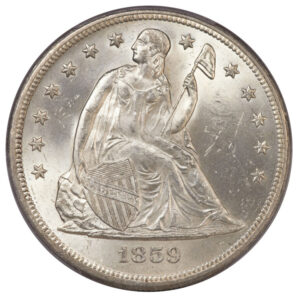
Coin Snapshot
- Weight: 26.73 grams
- Composition: 90% silver, 10% copper
- Diameter: 38.1 mm
- Thickness: 2.4 mm
- Years Minted: 1840-1873
- Designed by: Christian Gobrecht
- Total Coins Struck: Approximately 6.5 million (all years combined)
The Seated Liberty Dollar, minted from 1840 to 1873, was one of the earliest and longest-running silver dollar designs in U.S. history. Featuring the symbolic image of Liberty seated on a rock, this coin embodied the nation’s ideals of freedom and unity during a period of growth and change. Designed by Christian Gobrecht, the Seated Liberty Dollar reflects the neoclassical art style popular during the 19th century and stands as a reminder of America’s expanding influence on the world stage.
The coin played a crucial role during a time of political, economic, and territorial expansion. With the discovery of vast silver deposits, most notably the Comstock Lode, the production of silver dollars soared, fueling trade and commerce. Today, the Seated Liberty Dollar remains a treasured piece of numismatic history, offering collectors a tangible connection to a pivotal era in U.S. history.
Obverse Design
The obverse of the Seated Liberty Dollar, designed by Christian Gobrecht, features a striking depiction of Liberty seated on a rock. She holds a staff topped with a liberty cap, symbolizing freedom, while her right hand rests on a shield emblazoned with “LIBERTY.” This design reflects the classical imagery of the time, embodying America’s ideals of independence and strength.
Around the rim of the coin, stars representing the original 13 colonies surround the image of Liberty, with the date of minting appearing below. This design was not only aesthetically pleasing but also symbolically powerful, representing a young nation’s aspirations and ideals during a period of expansion and discovery.
Reverse Design
The reverse of the Seated Liberty Dollar features a majestic eagle with outstretched wings, clutching an olive branch and arrows in its talons. This imagery was a direct nod to the Coinage Act of 1792, which specified that the eagle should appear on U.S. coinage to symbolize strength and peace. The eagle faces left, toward the olive branch, emphasizing the nation’s preference for peace, while the arrows in its right talon highlight the readiness for defense.
The reverse also includes the inscriptions “UNITED STATES OF AMERICA” around the top and the denomination “ONE DOL.” along the bottom. In 1866, the motto “In God We Trust” was added to the reverse above the eagle, reflecting the nation’s growing spiritual identity during and after the Civil War.
Mint Locations and Mintmarks on the Seated Liberty Dollar
The Seated Liberty Dollar was minted in several key locations, each with its own unique mintmark. These mints were instrumental in meeting the growing demand for silver coinage during the mid-19th century.
- Philadelphia Mint: As the nation’s first and primary mint, the Philadelphia Mint struck the majority of Seated Liberty Dollars. Coins minted here do not have a mintmark.
- New Orleans Mint: The New Orleans Mint produced Seated Liberty Dollars from 1846 to 1860. Coins minted here feature an “O” mintmark.
- San Francisco Mint: The San Francisco Mint began minting Seated Liberty Dollars in 1859. These coins are identified by an “S” mintmark.
- Carson City Mint: Carson City struck Seated Liberty Dollars from 1870 to 1873. These coins, bearing the “CC” mintmark, are particularly prized by collectors due to their lower mintage numbers and association with the Nevada silver boom.
Coins from different mints can have significant differences in rarity and value, with those from the Carson City and San Francisco mints often commanding higher premiums. Collectors often seek out specific mintmarks to complete their sets, with certain dates and mints being rarer and more valuable than others.
History of the Seated Liberty Dollar
The Seated Liberty Dollar was introduced in 1840 as part of a larger movement to standardize U.S. coinage and improve its artistic quality. Christian Gobrecht’s design was an evolution of earlier ideas, incorporating classical elements and symbolic imagery to create a coin that would represent America’s values on the world stage. The coin’s production coincided with significant events in American history, including the Mexican-American War, the discovery of gold in California, and the Civil War.
One of the key factors behind the Seated Liberty Dollar’s production was the influx of silver from the Comstock Lode in Nevada, which dramatically increased the nation’s silver supply. This led to the minting of larger quantities of silver dollars, including the Seated Liberty Dollar. However, the coin faced competition from paper currency and gold coins, leading to fluctuating production numbers throughout its history.
In 1873, the Coinage Act (often referred to as the “Crime of 1873”) effectively ended the production of silver dollars, including the Seated Liberty Dollar. The decision to discontinue the silver dollar was driven by economic factors and the increasing use of gold as the standard for currency. Although production ceased, the Seated Liberty Dollar remained a key piece of American numismatic history.
Seated Liberty Dollar Prices
The value of a Seated Liberty Dollar varies widely based on factors such as its year, mintmark, and condition. Common-date coins in circulated condition can sell for several hundred dollars, while rare dates or coins in mint condition can reach thousands or even tens of thousands of dollars.
Certain coins, such as those minted at the Carson City Mint or during lower-production years like 1871, can command significantly higher prices. Coins in mint state, particularly those graded by third-party grading services like PCGS or NGC, are especially desirable among collectors. Additionally, the presence of varieties, such as doubled dies or other minting anomalies, can also impact a coin’s value.
Examples of Rare and Expensive Seated Liberty Dollars
Some of the most valuable Seated Liberty Dollars include the 1870-CC, which is highly sought after due to its rarity and the limited number of coins minted at the Carson City Mint. Another rare coin is the 1873-S, which is another highly coveted coin due to its extremely low mintage. The 1873-S Seated Liberty Dollar was minted in very small quantities before the Coinage Act of 1873 halted production, making it a key rarity in the series.
Other rare dates that are especially valuable include the 1851 and 1852 Seated Liberty Dollars, which were struck in limited numbers. These coins were produced at a time when silver dollar production had significantly decreased due to economic conditions. Coins from these years, especially in high grades, can fetch prices well into the tens of thousands of dollars at auction.
Collectors are particularly drawn to rare mintmark varieties, such as the “CC” coins from Carson City, which are not only rare but also carry historical significance tied to the Nevada silver boom. High-grade coins from the San Francisco and New Orleans mints also command premiums, especially when they have strong eye appeal and minimal wear.
Seated Liberty Dollar Condition and Certification
As with any valuable coin, the condition of a Seated Liberty Dollar significantly affects its value. Most coins that have survived to the present day show signs of circulation, making uncirculated examples particularly rare and desirable. Coins are graded on the Sheldon scale, which ranges from 1 to 70, with higher numbers representing better-preserved coins.
Certified coins, graded by professional services such as the Professional Coin Grading Service (PCGS) or the Numismatic Guaranty Corporation (NGC), are especially prized by collectors. These services provide an unbiased assessment of a coin’s condition and authenticity, offering peace of mind to buyers and sellers. Certified Seated Liberty Dollars in higher grades, especially those with rarer mintmarks, can reach substantial prices at auction or in private sales.
Coins graded as “mint state” (MS) are particularly valuable. These are coins that were never circulated and show no signs of wear. However, even circulated examples in grades such as Very Fine (VF) or Extremely Fine (EF) can be highly collectible, especially when they have rare dates or mintmarks.
Buying Seated Liberty Dollars Online
Purchasing Seated Liberty Dollars online can provide collectors with access to a wide range of coins in various conditions and price points. However, it is important to buy from reputable dealers or auction houses to ensure the authenticity of the coin. Certified coins are generally a safer purchase, as they have been graded and authenticated by trusted third-party organizations.
When buying online, collectors should consider the coin’s provenance, grading, and seller reputation. It’s advisable to purchase from dealers who offer return policies and provide clear, high-resolution images of the coin. Auction platforms such as Heritage Auctions and Stack’s Bowers Galleries often feature Seated Liberty Dollars in their sales, giving collectors the opportunity to bid on rare and high-grade examples.
Collectors should also keep an eye out for varieties or error coins, which can significantly increase the value of a Seated Liberty Dollar. These coins, which may feature unique minting anomalies, are often listed at a premium but can be valuable additions to any collection.
Conclusion
The Seated Liberty Dollar is a significant part of U.S. numismatic history, symbolizing the country’s growth and development during the 19th century. Its design by Christian Gobrecht, coupled with its rich historical context, makes it a must-have for collectors interested in early American coinage. Whether you are drawn to the artistry of the coin, its historical importance, or its investment potential, the Seated Liberty Dollar offers something for every collector.
As with all rare coins, condition, rarity, and certification play crucial roles in determining the value of a Seated Liberty Dollar. Collectors are advised to seek out certified examples from trusted dealers and auctions to ensure authenticity and quality. With a variety of mintmarks and date ranges available, this iconic coin offers endless opportunities for discovery and appreciation within the world of coin collecting.
